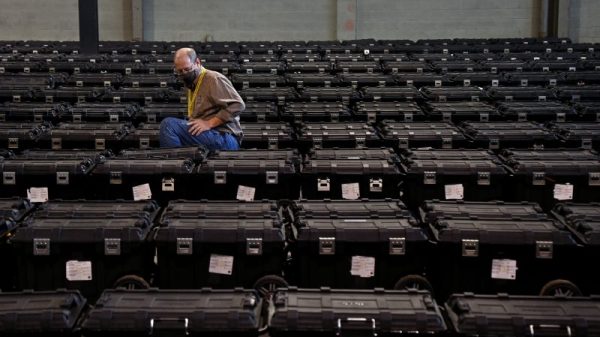Astronomers using the James Webb Space Telescope have for the first time detected tiny quartz crystals containing silica — a common mineral on Earth — within the atmosphere of a blazing hot exoplanet.
It’s likely that the nanoparticles of silica, which on Earth appears in beach sands and is used to produce glass, swirl from the clouds of the exoplanet, known as WASP-17b, according to the researchers.
First discovered in 2009, WASP-17b is a gas giant planet located 1,300 light-years from Earth. It has a volume more than seven times that of Jupiter, making it one of the largest exoplanets known to astronomers.
The researchers detected the the quartz nanoparticles in high-altitude clouds using Webb’s Mid-Infrared Instrument, according to new research published Monday in The Astrophysical Journal Letters.
“We were thrilled,” said lead study author David Grant, a researcher at the University of Bristol, in a statement. “We knew from Hubble observations that there must be aerosols — tiny particles making up clouds or haze — in WASP-17 b’s atmosphere, but we didn’t expect them to be made of quartz.”
Minerals rich in silicon and oxygen, called silicates, are plentiful on Earth, the moon and other rocky bodies in the solar system. Silicates are also incredibly common in the Milky Way galaxy. But so far, the silicate grains detected in exoplanet atmospheres have been magnesium-based, not quartz, which is made of pure silica.
“We fully expected to see magnesium silicates,” said study coauthor Hannah Wakeford, senior lecturer in astrophysics at University of Bristol, in a statement.
“But what we’re seeing instead are likely the building blocks of those, the tiny ‘seed’ particles needed to form the larger silicate grains we detect in cooler exoplanets and brown dwarfs.”
The finding could enable researchers to understand the materials used to form planetary environments much different from what we know on Earth.
What the quartz crystals reveal about WASP-17b
Wasp-17b takes 3.7 Earth days to complete one orbit around its star. Astronomers focused their observations on the exoplanet as it crossed in front of its star and starlight filtered through its atmosphere.
After 10 hours of observation time, the team discovered a signature suggesting the presence of quartz nanoparticles.
The quartz crystals are likely hexagonal in shape, like the much larger geodes we know on Earth, but each one is only one-millionth of a centimeter — so small that 10,000 of the grains could fit side by side across a human hair, according to the research. And the particles originate in the atmosphere.
“WASP-17 b is extremely hot — around 2,700 degrees Fahrenheit (1,500 degrees Celsius) — and the pressure where the quartz crystals form high in the atmosphere is only about one-thousandth of what we experience on Earth’s surface,” Grant said. “In these conditions, solid crystals can form directly from gas, without going through a liquid phase first.”
The planet is tidally locked to its star, meaning one side always faces the star and experiences searing temperatures, while the permanent “night” side of the planet is cooler. While the clouds can drift around the planet, they likely vaporize on the hot day side, which could send the quartz particles swirling.
“The winds could be moving these tiny glassy particles around at thousands of miles per hour,” Grant said.
Webb’s sensitive detections are allowing researchers to have a better understanding of the atmospheres, environmental conditions and weather on planets outside of our solar system.
Hot gas giants, also called Hot Jupiters, like WASP-17b are largely composed of hydrogen and helium, along with some water vapor and carbon dioxide. Detecting silica in the planet’s atmosphere helps scientists to have a broader sense of WASP-17b’s composition.
“If we only consider the oxygen that is in these gases, and neglect to include all of the oxygen locked up in minerals like quartz, we will significantly underestimate the total abundance,” Wakeford said. “These beautiful silica crystals tell us about the inventory of different materials and how they all come together to shape the environment of this planet.”







































